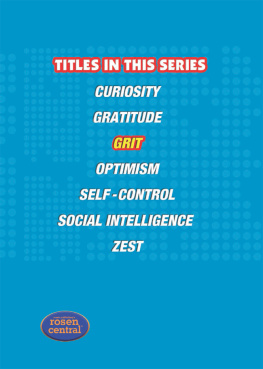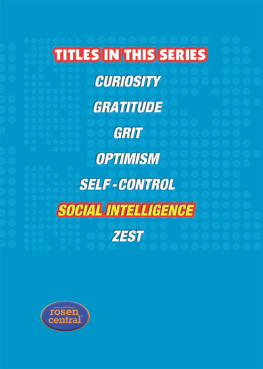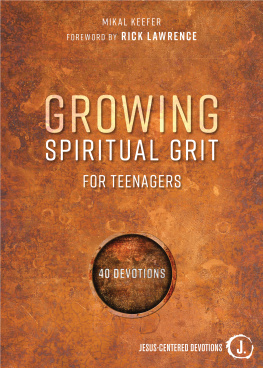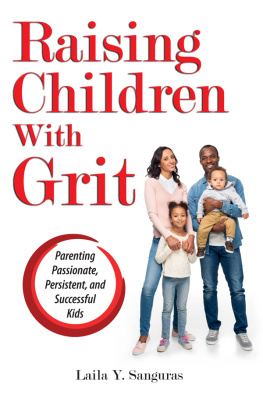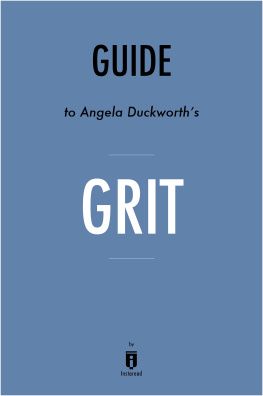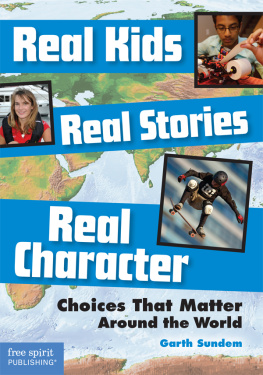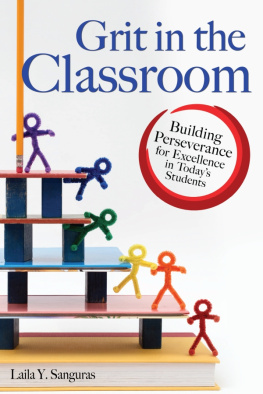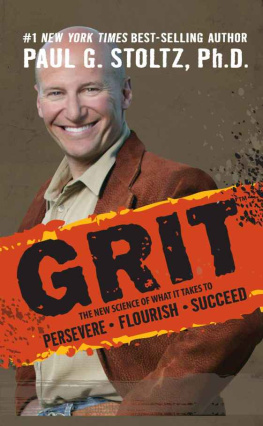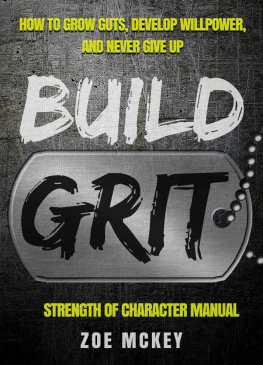Published in 2014 by The Rosen Publishing Group, Inc.
29 East 21st Street, New York, NY 10010
Copyright 2014 by The Rosen Publishing Group, Inc.
First Edition
All rights reserved. No part of this book may be reproduced in any form without permission in writing from the publisher, except by a reviewer.
Library of Congress Cataloging-in-Publication Data
Siddoway, Ramona.
Grit/by Ramona Siddoway.1st ed.New York: Rosen, c2014
p. cm.(The 7 character strengths of highly successful students)
Includes bibliographical references and index.
ISBN: 978-1-4488-9540-3 (Library Binding)
ISBN: 978-1-4488-9559-5 (Paperback)
ISBN: 978-1-4488-9560-1 (6-Pack)
1. Work ethicJuvenile literature. 2. ResponsibilityJuvenile literature. 3. Self confidence in adolescenceUnited States. I. Title.
HQ796 .S53 2014
155.5182
Manufactured in the United States of America
CPSIA Compliance Information: Batch #S13YA: For further information, contact Rosen Publishing, New York, New York, at 1-800-237-9932.
CONTENTS
CHAPTER 1
ITS ALL UP TO YOU
CHAPTER 2
EMOTIONAL GRIT
CHAPTER 3
ACADEMIC GRIT
CHAPTER 4
PHYSICAL GRIT
CHAPTER 5
LIVING THE GRITTY LIFE
INTRODUCTION
K imberly Salmeri was born with two tumors known as lipomas wrapped around her spine. She had her first surgery at only ten months old. Despite several later surgeries, by the age of fourteen she had lost the use of her legs. Yet, through some incredible persistence, she somehow willed herself to walk. Mostly wheelchair-bound today, Kim has limited mobility and is able to walk a little, but only with intense physical therapy. But that doesnt slow her down. She decided that she would not let being confined to a wheelchair hinder her from helping others.
As a high school sophomore, Kim began raising money for CPLCanine Partners for Life Organization. This group trains companion dogs to help individuals with disabilities lead a more independent life. For four years in a row she has raised thousands of dollars for the organization. Darlene Sullivan, executive director and founder of CPL, remarked that Kim has a huge heart and great leadership abilities.
My struggles make me appreciate things that most people take for granted, says Kim. She really believes in people doing what they can to be self-reliant and independent, despite whatever disabilities they may have or adversities they may encounter. By focusing on helping others, she is able to face her own challenges in life. Kim is a person with true grit.
Kim Salmeri has demonstrated an astonishing amount of grit, resiliency, determination, and generosity not only in rising above her own struggles with illness and disability, but also in being so committed to helping others who face similar struggles.
Grit means more than just perseverance. Grit is perseverance in the face of long odds, daunting obstacles, emotional or physical pain, exhaustion, and even isolation. Grit is displaying resilience or persistence through adversity or discouragement. It is enduring a trying situation without complaint. It takes a firmness of character to have grit, to move toward a goal despite fear or failure. Some people call it stick-to-it-iveness. Persistence is not necessarily a guarantee that a person will succeed, but any success is improbable without it. Most accomplishments and goals require a person to persist and stick with it for a certain period of time, whether it is for days, months, or years.
So why do some people seem to have more grit than others? Can grit be developed? Studies have shown that even just anticipating or believing in a positive outcome will promote and foster greater resilience and persistence. Conversely, having a poor attitude often decreases the reserve of grit that one can draw upon. Negativity and pessimism also increase the likelihood of quitting. The greater the positive mental attitude, the deeper and more sustaining the reserves of grit are.
Grit is a character trait that can certainly be developed, nurtured, improved, and strengthened. With training and practicepeople have shown marked improvements in their ability to persist and persevere even when faced with failure and setbacks. The following sections will discuss the different types of grit and how to develop and practice them.
CHAPTER 1
ITS ALL UP TO YOU
J ordan Arbour fell out of a shopping cart at the age of three, resulting in extensive brain injuries. Jordan regressed and spent the next seven years relearning everything he had once known, including how to walk and talk. Normally brain injuries of this type leave a person permanently disabled and plagued by severe memory and coordination problems. In sixth grade, Jordan was still struggling to tie his shoes. It took a lot of determination from both Jordan and his mother to endure the many frustrations and setbacks of his years-long rehabilitation.
Things finally began to click, however, and at age sixteen, Jordan sat down at the piano and, without any previous lessons, began to play Chopins Opus 25 Ocean Etude. It was at that moment that Jordan decided he wanted to be a concert pianist. After a lot of grit that included finding a teacher who would be patient enough to teach him how to read music and deal with some slight lingering ticks from his accident, at age nineteen Jordan can now read music. He is enrolled as a music and math major at the University of Utah. His success is due in large part to the enormous amount of grit displayed by both him and his mother.
The support and assistance of an entire community of gritty people are often needed in lifefamily, friends, and community members. This is known as community resilience.
Jordans story illustrates not only a personal and individual display of grit, but also that the support and assistance of an entire community of gritty people are often needed in lifefamily, friends, teachers, and community members. Community resilience is built upon the grit of individuals who come together to offer mutual support so that strength and resolve extend outward in wider and wider circles. A person who demonstrates grit can be an example to others and help those around him or her to tap into their own reserves of grit when struggling with adversity.
THE MEANING OF GRIT
Grit is overcoming challenges and trials to achieve a goal. We sometimes call this trait perseverance, determination, or resilience. It is this character trait that makes it possible for an individual to stick to a task no matter how daunting the challenge or how high the obstacles that stand in the way. A gritty person keeps trying no matter how hard it gets, even whenor especially whenhe or she faces failure, hardship, pain, exhaustion, fear, ridicule, or opposition. A gritty person realizes that bad times and setbacks are only temporary. Perhaps an old saying says it best: When the going gets tough, the tough get going.
Grit is being stubborn in a good way, refusing to give up on or quit something because you know deep down that it is important to see it through to the end, whatever the short-term pain and personal cost. It means refusing to take no for an answer and refusing to be rejected or turned back. Showing grit is refusing to let anything stand between you and your goal, whatever that goal may be: getting a better grade, studying for a hard test, learning a new instrument, overcoming a difficult past, or even just becoming a better person. All of these goals take a lot of determination. Grit can make a person do things that he or she didnt previously think were possible.

